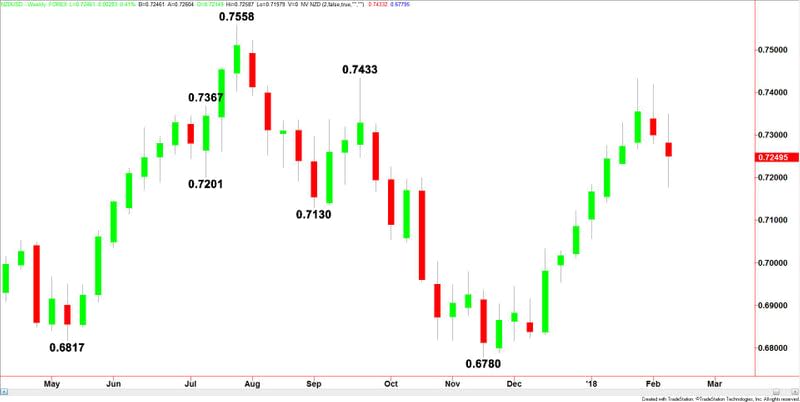AUD/USD and NZD/USD Fundamental Weekly Forecast – Major Events This Week Highlighted by U.S. Consumer Inflation
The Australian and New Zealand Dollars closed lower for a second week as investors succumbed to pressure from rising U.S. interest rates, lower commodity prices and the shedding of risky assets. Investors also reacted to dovish remarks from the respective central banks and unimpressive economic data.
The AUD/USD settled at .7809, down 0.0110 or -1.39% and the NZD/USD finished the week at .7250, down 0.0050 or -0.68%.

Rising U.S. Treasury yields have been triggering violent responses in the financial markets since the first week in February. A rise in the U.S. 10-year Treasury Note above 2.70 percent to 2.885 percent triggered a massive sell-off in U.S. equity markets.
The increased volatility encouraged investors to shed risky assets, commodities and commodity-linked currencies, driving them to seek protection in so-called safe-haven assets.
Relatively dovish comments from RBA chief Philip Lowe, the RBA monetary policy statement and RBA interest rate decision also weighed on prices.
The RBA once again said that an appreciating currency would dampen the outlook for domestic growth and inflation. The central bank also trimmed its unemployment forecasts slightly out to mid-2019 (now 5.25% rather than 5.5%), but kept its forecast for underlying inflation just about unchanged, expecting core consumer price growth of 2% by the end of 2019. The RBA also noted modest improvements in household consumption and a sunny outlook for business investment.
The RBA also said that growth is expected to remain reasonably upbeat by developed-market standards. Gross Domestic Product gains of 3.2% are still forecast this year and next. December loan levels also fell 2.3% versus an expected 1% slip.
Earlier in the week, the RBA left its benchmark interest rate at a record low of 1.50% this month, as widely expected. Traders think the next move when it comes will be a rate increase, but they don’t expect it until the end of this year at the earliest according to futures market pricing.

New Zealand Dollar
The Reserve Bank of New Zealand held its official cash rate steady at 1.75 percent saying monetary policy will “remain accommodative for a considerable period.”
Acting Reserve Governor Grant Spencer kept the official cash rate unchanged at 1.75 percent and continued to signal rates would not lift until the latter half of next year at the earliest due to the lack of inflationary pressure.
“Monetary policy will remain accommodative for a considerable period,” Spencer said in a statement. “Numerous uncertainties remain and policy may need to adjust accordingly.”
The Reserve Bank now sees annual inflation at 1.1 percent in the March quarter versus a prior forecast of 1.5 percent. It does not expect inflation to remain to the mid-point of its 1 percent-to-3 percent target band until September 2020 versus a prior forecast of June 2018.
Forecast
The major events out of New Zealand this week will be the quarterly Inflation Expectations and Business NZ Manufacturing Index.
Australia will feature the Employment Change and Unemployment Rate reports as well as a speech by RBA Governor Philip Lowe.
The major U.S. reports this week that should influence the price action are consumer inflation, retail sales, producer inflation and building permits.
On February 14, traders will get the opportunity to react to the monthly CPI report. Consumer inflation is expected to rise 0.3%. Core CPI is expected to come in 0.2% higher.
Retail Sales are expected to rise 0.5%. Core Retail Sales are called 0.2% higher.
Producer Inflation (PPI) is expected to rise 0.4%. Building Permits are forecast at 1.31M, slightly above the previous 1.30M.
Stronger-than-expected U.S. consumer inflation data will likely be bearish for the AUD/USD and NZD/USD because it will signal that inflation is rising and that the Fed may have to raise interest rates more aggressively this year.
This article was originally posted on FX Empire

 Yahoo Finance
Yahoo Finance 